Mysuru, KARNATAKA :
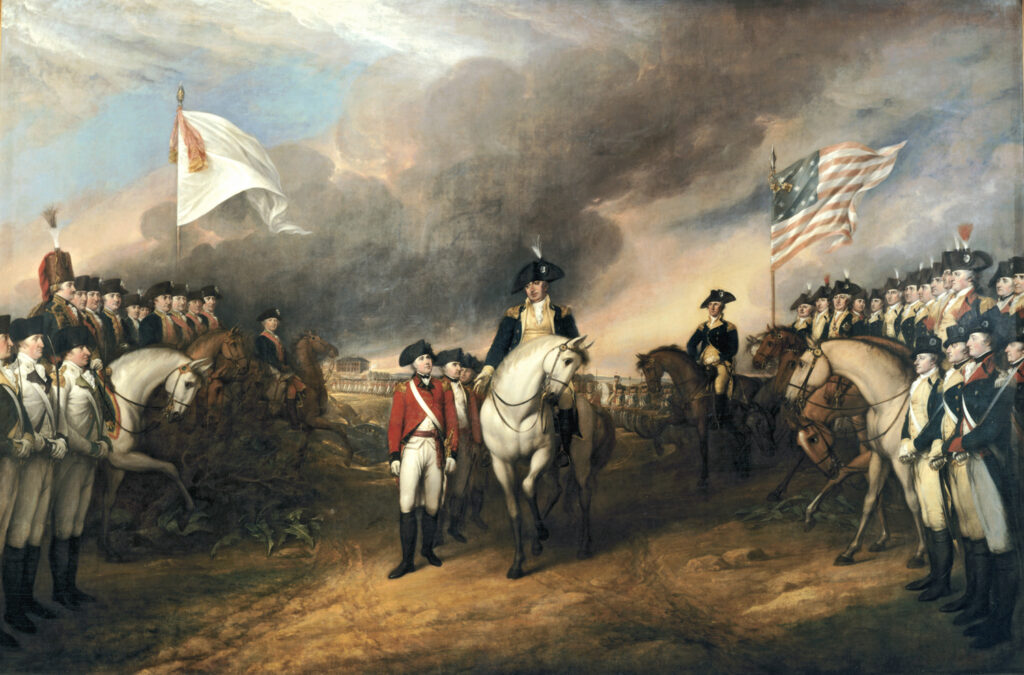
Hyder Ally (Anglicised version of Haidar Ali) was a popular exotic name in the 1770s when the fledgling United States of America was fighting for its independence from Britain. There were racehorses named after this ruler of the Mysore Kingdom in South Asia as well as his warrior son Tipu Sultan.
In the early 1780s, Haidar Ali’s bravery was invoked in one of the earliest documented recruitment for the US Navy. A ship named after him gave the USA one of its greatest naval victories during the same time. His name was chanted on the streets of America, in 1781. Let’s travel back in time to understand this.
In 1775, a great upheaval shook thirteen British colonies on the east coast of North America as its residents rose against the Government of Great Britain, declared independence and flew their own flag (1, 2). Apparently, the first flag of the Union, now the US national flag- the Stars and Stripes, sent to the state of Maryland was hosted on a sailboat by teenager Joshua Barney at Baltimore in October 1775. Barney had just started his service with the US Navy.
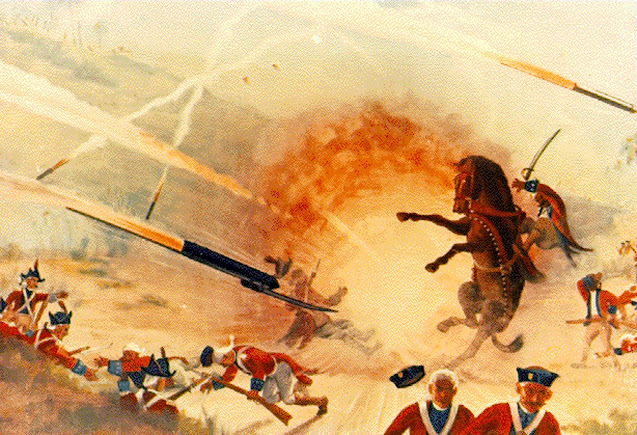
A few years later- in 1780, in the far-away Mysore Kingdom, the East India Company was suffering one of the worst reverses in its military history. This was at the hands of Haidar Ali and his son Tipu Sultan who were supported by the French, an ally of America. The humiliation of the British at the Battle of Pollilur in September 1780 reverberated in America where the news reached the country (3). On 19 October 1781, the British land force led by Charles Cornwallis surrendered to the Americans led by George Washington (incidentally a decade later in India, Cornwallis gave EI Company and its Indian allies victory over Haidar Ali’s son Tipu Sultan in the 3rd Anglo Mysore War). Nine days later Cornwallis’ surrender, along with that of Haidar Ali’s victories in India, was celebrated at Trenton, New Jersey. The town on that day was decorated with American colours. Inhabitants including the Who’s Who attended a service at the Presbyterian Church, where a discourse highlighting the occasion was delivered by a Reverend. In the afternoon the gathering drank 13 toasts accompanied with a discharge of artillery, number eleven of which was for ‘The great and heroic Hyder Ali, raised up by Providence to avenge the numberless cruelties perpetrated by the English on his unoffending countrymen, and to check the insolence and reduce the power of Britain in the East Indies‘ (ibid., ref. 3).
The other toasts were raised and artillery was discharged for the below. Quote:
1. The United States of America;
2. The Congress;
3. The king of France;
4. General Washington and the American army;
5. The Count de Rochambeau and the French army;
6. The Count de Grasse and the French fleet;
7. General Greene and the Southern army;
8. The friends of liberty throughout the world;
9. The memory of Generals Warren, Montgomery, and all the other heroes who have fallen in the defence of the liberties of America;
10. Peace on honorable terms, or war forever;
12. The governor and State of New Jersey;
13. The glorious 19th of October, 1781. At seven in the evening the company retired, and the rejoicings were concluded by a brilliant illumination.
Unquote. (ibid., ref. 3).
Hyder Ally and America’s struggle to reclaim its seas from the British
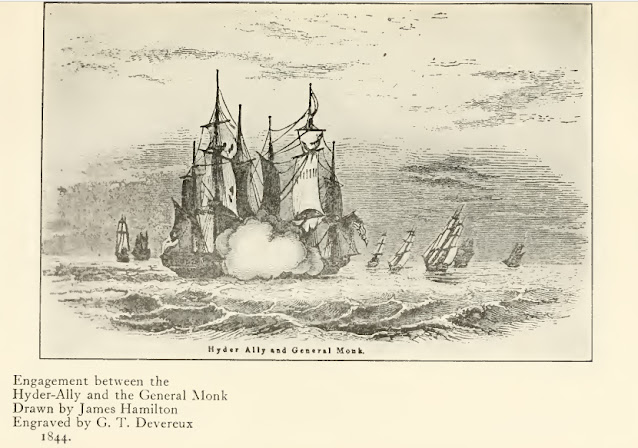
Source: Life of Commodore Joshua Barney, Hero of the US Navy (1776-1812), 1912.
Despite this, America was far from being an independent nation. The British still ruled the seas. They kept a keen watch on the ships entering and exiting the ports of northeast USA, often capturing the vessels and looting goods. General Washington an American sloop-of-war was captured by Admiral Arbuthnot, and placed in the king’s service under a new name The General Monk, which was then used to pirate American ships. By 1782 the commerce of Philadelphia City, as well as the ordinary life of the residents of the coast and nearby streams, was deteriorating. The fledgling American Union was not in a position to protect the affected vessels. Therefore the State of Pennsylvania, at its own expense, fitted a number of armed vessels that operated in waters leading to Philadelphia. The state purchased Hyder Ally, a small sloop (single mast ship) equipped with sixteen six-pounder guns to help protect the American vessels. 23-year old Lieutenant Joshua Barney, now in the US navy, arrived at Philadelphia where he was honoured with the command of Hyder Ally (4). Assigned with recruiting men, Barney used a poem penned by Philip Morin Freneau to attract young American men to the ship. The poem exalted Haidar Ali’s bravery against the British with the following lines (5):
Come, all ye lads who know no fear,
To wealth and honour with me steer
In the Hyder Ali privateer,
Commanded by brave Barney.
From an eastern prince she takes her name,
Who, smit with freedom’s sacred flame,
Usurping Britons brought to shame,
His country’s wrongs avenging;
Come, all ye lads that know no fear.
With hand and heart united all
Prepared to conqueror to fall.
Attend, my lads! to honor’s call —
Embark in our Hyder-Ally!
And soon Barney led a force of a hundred and ten men. On April 8, 1782, he received instructions to protect a fleet of merchantmen to the Capes just before the sea, at the entrance of Delaware Bay. Dropping the convoy at Cape May road he was awaiting a fair wind to take the merchant ship to sea when he saw three ships (6) which he realised were waiting to plunder the convoy. Barney immediately turned the convoy back into the bay, using Hyder Ally to cover the retreat. Soon the bigger General Monk under the command of Captain Rogers of the Royal Navy nearly doubled his own force of metal, and nearly one-fourth superior in number of men caught up with Hyder Ally. Despite being fired upon, Barney held Hyder Ally’s fire till within pistol shot when both the two vessels got entangled. A short but desperate fight ensued. Lasting 26 minutes, it resulted in the lowering of flags by General Monk indicating her surrender. Both vessels arrived at Philadelphia a few hours after the action bearing their respective dead. The Hyder Ally had four men killed and eleven wounded. The General Monk lost twenty men killed and had thirty-three wounded including Captain Rogers himself, and every officer on board, except one midshipman ! (7)
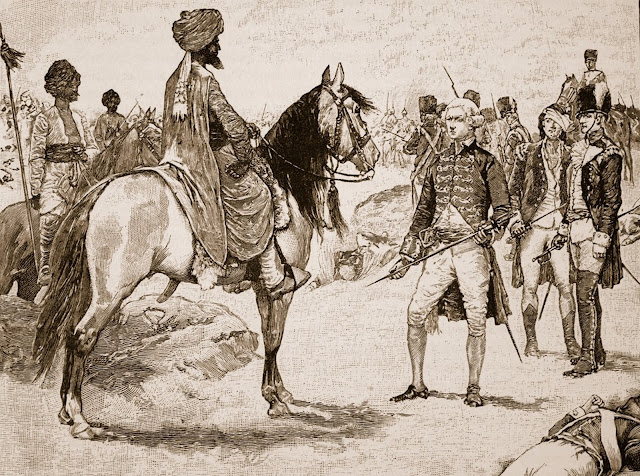
A hero is celebrated
Philadelphia burst in celebrations. Ballads were made upon this brilliant victory and sung through the streets of the city! And echoing with Barney’s name was that of Hyder Ally (ibid., ref. 1).Here are some lines:
And fortune still, that crowns the brave
Shall guard us over the gloomy wave —
A fearful heart betrays a knave!
Success to the Hyder-Ally!
While the roaring Hyder-Ally
Covered over his decks with dead!
When from their tops, their dead men tumbled
And the streams of blood did flow,
Then their proudest hopes were humbled
By their brave inferior foe.
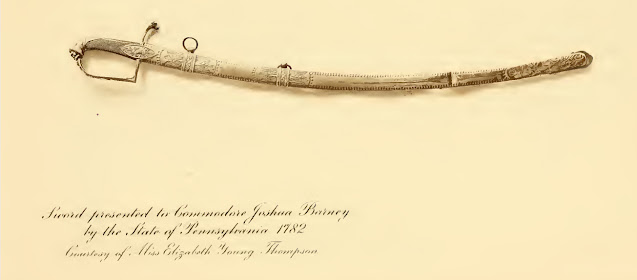
In 1782 the Legislature of Pennsylvania passed a vote of thanks to Captain Barney and ordered a gold-hilted sword to be prepared, which was afterwards presented to him in the name of the state by Governor Dickinson. It was a small sword with mountings of chased gold- the guard of which on the one side had a representation of the Hyder Ally, and on the other the General Monk (ibid., ref. 1). Barney was the last officer to quit the Union’s service, in July 1784, having been for many months before the only officer retained by the United States.
Barney was sent by the American Government to Paris. A reception was given in France him as a hero of dashing naval exploits during the Revolutionary War (8). A painting representing the action between the two ships was executed in 1802 by L. P. Crepin in Paris by order of Barney, while in the service of the French Republic. The same was presented by him on his return to the United States, to Robert Smith, Esquire, then secretary of the navy (9). The painting is now in the United States Naval Academy, Annapolis, Maryland (ibid., ref. 1). Barney was an intimate friend of Count Bertrand, one of Napoleon’s generals (ibid., ref. 2). Napolean incidentally had an alliance against the British with Haidar Ali’s son Tipu Sultan, during the latter’s lifetime (10).
Barney was appointed a Captain in the Flotilla Service, US Navy on 1814 April 25 (11). He took part in seventeen battles during the Revolutionary War and in nine battles during the War of 1812. A British Musket-ball lodged inside his body in battle at Bladensburg, Maryland in August 1814 (12). He passed away on December 1, 1818, aged 60.
The world today is considered a global village thanks to the scaling down of boundaries between nation-states and individuals alike. But it may surprise us even in the 18th century seemingly local political events and humans made an impact on lands and societies far away. The name Haidar Ali, after an adventurer from an obscure place in the erstwhile Kingdom of Mysore who gave many a lesson in military and political strategies to global colonial powers of England and France, echoing across the proverbial seven seas in distant North America for nearly a century is a testament of this (13, 14).
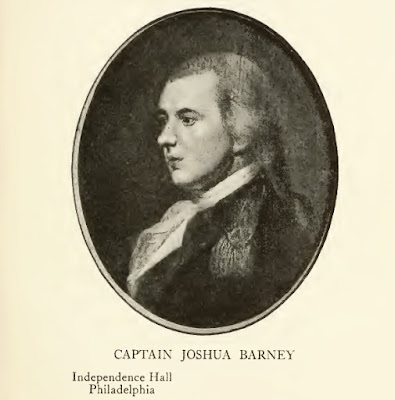
70 years after Hyder Ally’s victory over General Monk, James Cooper wrote “This action has been justly deemed one of the most brilliant that ever occurred under the American Flag. It was fought in the presence of a vastly superior force that was not engaged, and the ship taken was in every essential respect superior to her conqueror.” (ibid., ref. 4)
Sources/ Notes:
1. Barney, Mary., A biographical memoir of the late Commodore Joshua Barney, 1832, Mary was a sister of Joshua Barney. Her book provides in-depth information about the latter’s personal and military life. Born on July 6, 1759, 13-year old young Philadelphia Joshua Barney set sail on his maiden merchant ship journey to Ireland in 1771 with his brother in law Captain Thomas Drysdale. He sailed back home the following year and made trips to ports in Europe again. He set sail for Nice, France in December 1774 during which journey Captain Drysdale died. He took control of the ship which needed urgent repairs and therefore docked at Gibraltar, Spain instead. In a few months, he sailed to Algiers, Algeria from Alicant, Spain to deliver Spanish troops during which he witnessed the annihilation of these troops by the Algerians which made him return to Alicant soon. He immediately set sail across the vast Atlantic Ocean for Baltimore, USA. As he entered the Chesapeake Bay on 1st October he was surprised by the British Sloop of war Kingfisher. An officer searched his ship and informed him that Americans had rebelled and that battles were being fought. He was fortunate enough to escape detention. Returning to Philadelphia he was determined to serve the Americans fight against the British. At that time a couple of small vessels were under at Baltimore ready to join the small squadron of ships stationed then at Philadelphia and commanded by Commodore Hopkins. Barney offered his services to the commander of the sloop Hornet, one of these vessels. He was made the master’s-mate, the sloop’s second in command. A new American Flag, the first ‘Star-spangled Banner’ in the State of Maryland, sent by Commodore Hopkins for the service of the ten gun Hornet, arrived from Philadelphia. At the next sunrise, Barney unfurled it in all pomp and glory. In 1776, Robert Morris, President of the Marine Committee of the Congress offered him a letter of Appointment as a Lieutenant in the Navy of the United States in recognition of his efforts during a naval battle engagement in Delaware.
2. Adams, William Frederick., Commodore Joshua Barney: many interesting facts connected with the life of Commodore Joshua Barney, hero of the United States navy, 1776-1812, 1912. Adams provides a good summary of Mary Barney’s book in this book.
3. Moore, Frank., Diary of the American Revolution, Volume 2, 1860.
4. Cooper, James Fenimore., History of the Navy of the United States of America, 1853.
5. Freneau., Poems written and published during the American Revolutionary War, 1809.
6. Two ships and a brig- a sailing vessel with two masts.
7. As explained by Barney himself in his painting of this war commissioned later.
8. Bowen, A., The Naval Monument,1815, Concord, MA. This book gives an account of the reception received by Barney in France.
9. The painting was accompanied by a description, in the handwriting of Commodore Barney, which is reproduced in Mary Barney’s book.
10. Ahmed, Nazeer., https://historyofislam.com/tippu-sultan/ (downloaded October 13, 2017).
11. Record of Service, Bureau of Navigation, Navy Department, United States Navy.
12. The conduct of Commodore Barney, at the Battle of Bladensburgh, was appreciated by his military opponents as well. He was wounded in the engagement and was taken prisoner by General Ross and Admiral Cockburn but paroled on the spot. At the time of his death in 1818, the ball was extracted and given to his eldest son. For the valuable services of her husband, Congress granted Mrs. Barney a pension for life.
13. Goold, William., Portland in the past, 1886. This book has information on at least one more well-known ship named Hyder Ally built in the US in the 1800s after the one described in this story. This ship, like many other US ships, resorted to pirating British ships in the Indian Ocean all the way up to the island of Sumatra and around the Cape of Good Hope in South Africa in the run-up to the British-American War of 1812.
14. Corbett’s Annual register (1802) documents the ship ‘Tippoo Saib’ registered in Savannah, Georgia, the southernmost of the 13 colonies that declared independence from the British in 1776 and formed the original ‘United States of America’.
source: http://www.thecognate.com / The Cognate / Home> History / by Ameen Ahmed / December 27th, 2021








